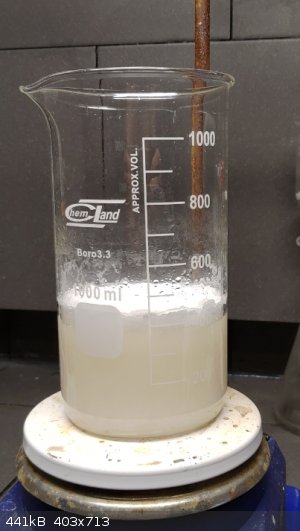
Yttrium2 - 25-8-2020 at 21:08
Hi all,
so I am looking at a few graduated cylinders here,
one is 100mL, one is 50mL, one is 10mL
the 100mL says 1.00, the 50mL says 1.0, and the 10mL says .2
Can anyone explain what these markings mean?
https://www.ebay.com/itm/Borosilicate-Glass-Graduated-Cylind...
Thanks
Yttrium2 - 25-8-2020 at 21:11
Also...
I've got a 400mL beaker, but the markings only go up to 300mL -- Can someone explain this?
Yttrium2 - 25-8-2020 at 21:13
when would I use an immersion thermometer if I could partially submerge a partial immersion thermometer?
outer_limits - 25-8-2020 at 21:28
As you can see below the cylinder's scale +-1.0, the first one has tolerance up to 1.0ml and the second (+-0.2)to 0.2ml
Regarding the beaker - I suppose someone sold you a beaker that has 400ml of total capacity and marking it would require making a line at the top of
it. The beaker's volume commonly means usable volume, not the total one. Filling it up to the top is possible but working with it is very difficult
because the probability of spill increases rapidly in direct propotion to used percentage of beaker's volume after exceeding some point. If it is
filled for example up to 80 percent, you can do anything conveniently but if it's filled to it's max any move can end in spilling the liquid over the
workplace
Yttrium2 - 25-8-2020 at 22:12
The first one was 1.00
but I'm guessing the smaller ones had a greater accuracy, that do not go out to 2 decimal places to the right of the decimal.
The beaker that I have got is corning pyrex, I'm guessing its markings should be legitimate. I didn't quite understand the reason in your post as to
why the beaker wouldn't have been marked at 400mL if it is a 400mL beaker?
outer_limits - 25-8-2020 at 22:53
Not really, but maybe it depends on the supplier.
For example, I bought this one as 1000ml and the marks are up to 1000ml.
This beaker's capacity is higher than 1000ml so I consider 1 liter as a working capacity - not the total.

[Edited on 26-8-2020 by outer_limits]
Sulaiman - 26-8-2020 at 03:44
Assuming that you have not ordered yet;
Nothing wrong with Class-B accuracy for volumetric cylinders,
but class-A has half the error and can sometimes be only a little more expensive.
I recently bought a cheap set of four measuring cylinders (5, 10, 50 and 100 ml, not Class-A or B)
that I measured to be accurate to within one sub-division !
and two sets of 5x beakers (5, 10, 25, 50 and 100 ml) - the graduation markings are more for decoration than accuracy 
... but they are cute 
'stem correction' is the term to research for details,
it is easiest to use a thermometer in the same conditions that it was calibrated for.
e.g. for a fish tank a complete immersion type may be best
and in a still head a 75mm partial immersion type may be best,
otherwise corrections need to be made - unnecessarily waking up a billion little grey cells.
In practice, unless you pay for calibrated thermometers, the stem correction is not important,
Tap water is generally good enough for calibrating at the b.p. and m.p. of water.
[Edited on 26-8-2020 by Sulaiman]
macckone - 26-8-2020 at 06:42
To answer the to the OP is the 1.0, 1.0 and 0.2 are the graduation markings.
You can generally estimate tenths of graduation markings.
The cylinders are class B.
A couple of notes are that weight is better than volume for reactants and
for solvents the volume is not as critical.
Also volume is temperature dependent.
Finally, you can generally use weight instead of volume if there are questions about molarity/normality of solutions.
For the graduate beaker question,
Some makers use full vs working capacity.
The standard is working capacity but it is not consistent.
Measurements on beakers are better for solvents and I would never use them to measure reactants.
As Sulaiman said unless you have quality thermometers the volume corrections are not going to be super accurate.


